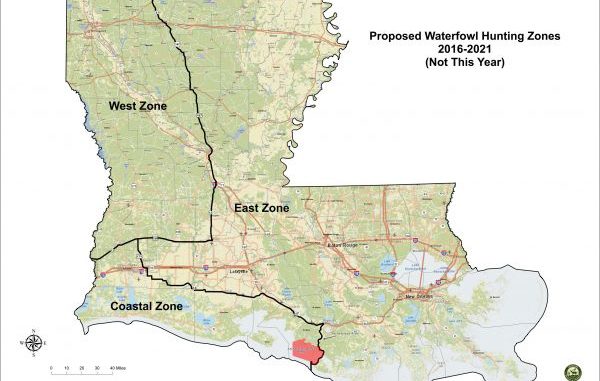
Contact Larry Reynolds with input during public comment period by Oct. 30
The entire Southeast Louisiana coast — including all of Lafourche Parish — would move into the East Zone for 2016, and large swaths of rice fields in Vermilion, Acadia and Jeff Davis Parishes currently in the Coastal Zone would also move into the East Zone next season if proposed waterfowl hunting zone boundaries are ultimately approved by the Louisiana Wildlife and Fisheries Commission at their next meeting on Nov. 5.
Larry Reynolds, the waterfowl study leader for the Louisiana Department of Wildlife and Fisheries, released a new zone map Monday after receiving input from the Commission at last week’s meeting and conducting six public meetings with hunters across the state in September.
To see the proposed boundary map, click here. To see the existing zone map boundaries, click here.
The key now is for the public to study the map and let Reynolds and the Commission know what they think of the changes, which could go into effect for the 2016-17 season.
He said it’s vital to voice your opinion — no matter if you’re for or against the new boundary lines.
“If you see this proposal and it’s what you like, don’t change channels and go get a sandwich. Give me a call and tell me, ‘Yes, this is what I like.’ We cannot afford to only hear from people who don’t like what’s been proposed,” Reynolds said. “We need to hear from you whether you like it or don’t like it, because if we’ve proposed something that you like and you go, ‘Yes, Wildlife and Fisheries finally got it right,’ and you change channels to watch the football game feeling good about the changes that are coming, they might not happen.”
Reynolds urged hunters to call him at his office at 225-765-0456 or to contact him via email to give him feedback on the proposed map. The deadline to comment by phone or email is Oct. 30, but the public is also invited to attend the Commission meeting on Thursday, Nov. 5 in Baton Rouge, he said.
Perhaps the biggest change is confining the Coastal Zone to just the Southwest and South Central coast, with a new Coastal Zone eastern boundary at the intersection of Highway 90 and the east bank of the Atchafalaya River down and around the Atchafalaya Delta WMA to Point Au Fer Island, then due south to the edge of state waters.
All of Plaquemines, St. Bernard, St. Charles and Jefferson Parishes would move into the East Zone under this proposal, as well.
“The entire Atchafalaya Delta WMA would remain in the Coastal Zone, and all of Terrebonne Parish is in the East Zone,” Reynolds said.
The East Zone typically has later season dates, which is why chunks of rice-growing acreage in Vermilion, Acadia and Jeff Davis Parishes could also potentially move into the East Zone, as well.
“The rice industry clearly wanted some relief from the early Coastal Zone seasons,” Reynolds said. “I said at the public meetings the rice and the marsh interact as a single habitat, and that it’s the juxtaposition of the rice and the marsh that leads to high-quality waterfowl habitat.
“Now there’s a lot of rice south of Highway 14 so that interchange can still occur, but now you’re going to have rice fields where the season is not open for a week or two while the marsh is shooting. I don’t know if it’s better or not — we’ll see what the public comment says.”
The current zig-zag in the boundary line between the East and West Zones in North Louisiana also would be removed under the new map, which would shift Kepler Lake from the East to the West Zone.
Every five years, the state has the opportunity to adjust zones and splits. This year, because the U.S. Fish and Wildlife Service will begin setting season frameworks in December rather than July, Reynolds said the Commission also has the option of doing nothing on zones and splits and making any potential changes in 2016. If that were the case, changes voted on next year would go into effect in 2017 and would be valid for four years.
But that’s an option Reynolds doesn’t support.
“I hope that we make a decision this year so that zone boundaries take effect in 2016 for the full five-year period,” he said. “And I think the way for that to happen is to get as much public participation in this comment period as possible.”


